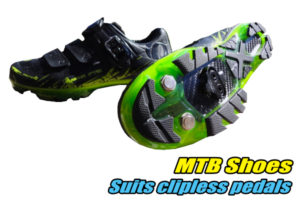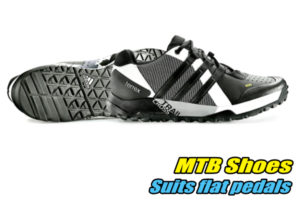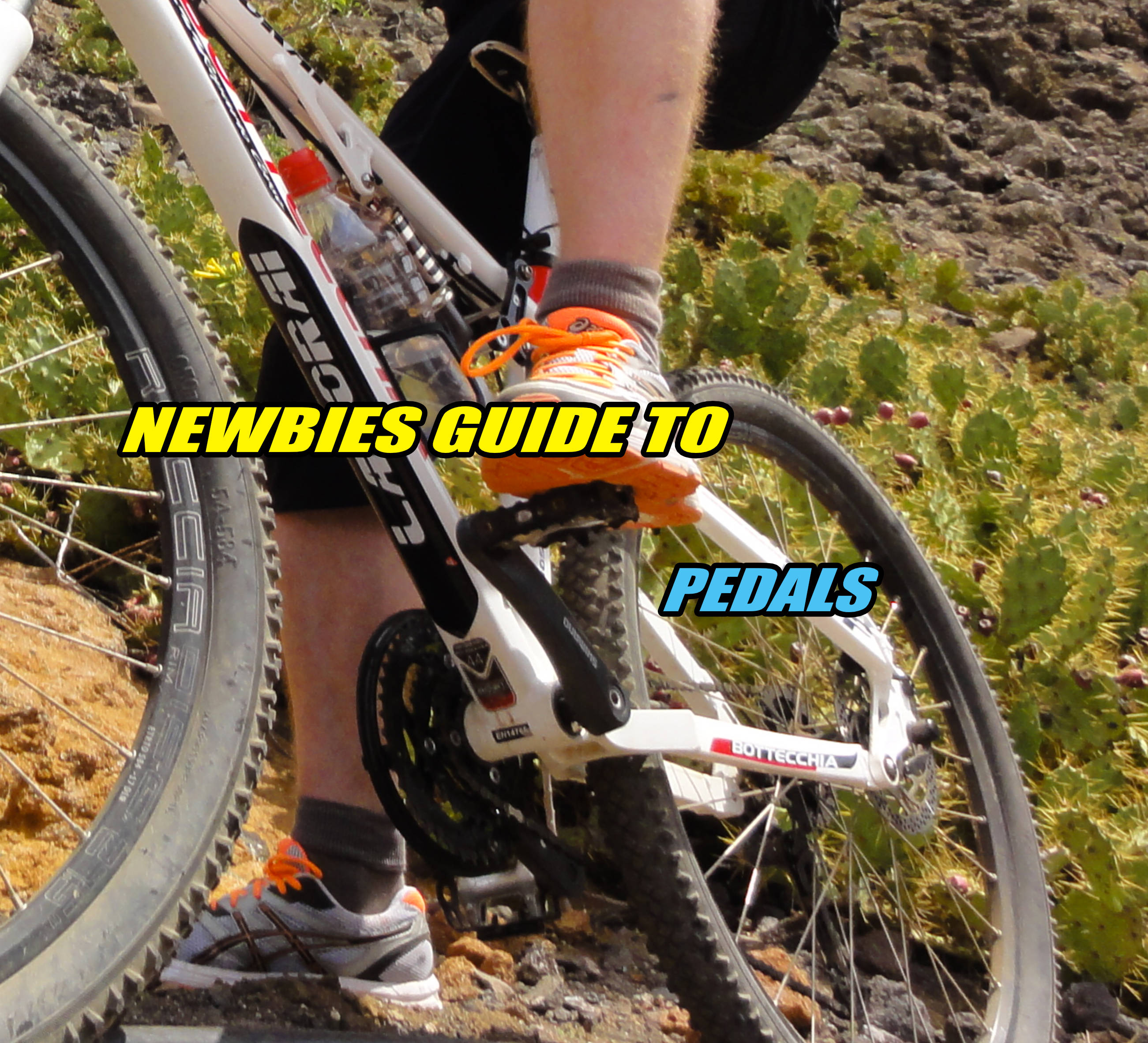It’s not long before beginners to MTB are faced with the ongoing pedal debate of whether to clip in or not. Looking around them, they’ll likely see riders using both clip in style pedals and the more simple flat pedals with no clip in device built in. Each user group will often passionately defend their choice of pedal type. For most beginners, this is a perplexing conundrum because they want to learn to ride properly but the thought of having their feet clipped onto a pedal is just frightening. So, let’s have a look at both pedal choices and try to help the newbies, and even those more experienced riders, make the choice that is right for them. And we’ll start by declaring there is no wrong choice here! Both are valid, and both have their own advantages and disadvantages.
What is a clip-in pedal?
Pedals that lock your feet to the pedal using a cleat (bracket on the shoe) and a clip in system on the pedal itself, are referred to as ‘clipless’ or ‘clip-in’. The term ‘clipless’ is misleading as your shoes do indeed clip in to these pedals. The term comes from when the changeover from toe clips and straps to clipless arrived back in the early to mid 80’s. Back then we had a metal or plastic ‘clip’ that bolted to the pedals and curved over the toe of the shoe. A leather or synthetic strap was threaded through the bottom of the pedal and up and over the shoe passing through a loop in the toe clip. The strap had a clip on it also that automatically locked up as you pulled it tight and easily released when you flicked the clip outwards with your finger. This single-sided pedal system is still used in track racing on velodromes today. Occasionally you’ll see a mountain biker using them without any straps (so they can get their foot free easily) as a compromise between the clipless and flat choices.
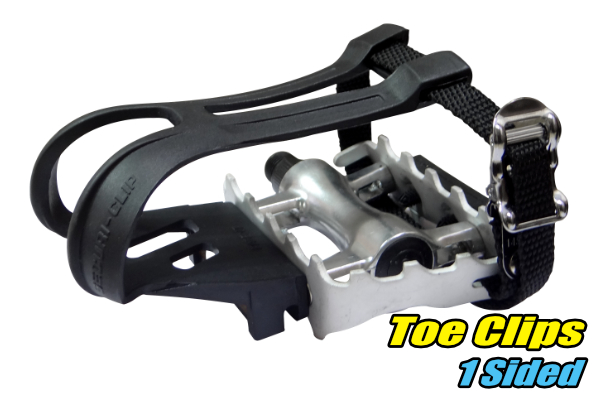
When the new pedals called ‘clipless’ pedals arrived they, like the modern versions, had no toe clip bolted to the pedal and also had no strap. A cleat fixed to the bottom of the shoe clipped in to a clip in device built into the pedal. So due to no toe clip curling over your shoe, the pedals were called ‘clipless’ pedals. You’ll also hear them referred to as clip-in pedals and, because they have a large share of the market, you’ll hear them also often referred to ‘SPD’s’ which is only accurate if you are referring to the Shimano brand or similar of clip in pedals using Shimano’s SPD (Shimano pedalling Dynamics). There are several brands and variations of clip-in pedals (which are two-sided these days) but they all use a cleat fixed to the shoe and a pedal with a built in clip system that allows you to lock your shoes to the pedal and easily release them with a swivel movement of your foot when you need to. Clip-in pedals come in a minimal style pedal which is not much more than an axle and the clip-in system or with a small platform around the clip in system which some riders find adds stability and ease of clipping in. Clip-in pedals require a proper clip-in compatible MTB shoe which is designed and shaped to deliver maximum power to the pedals.
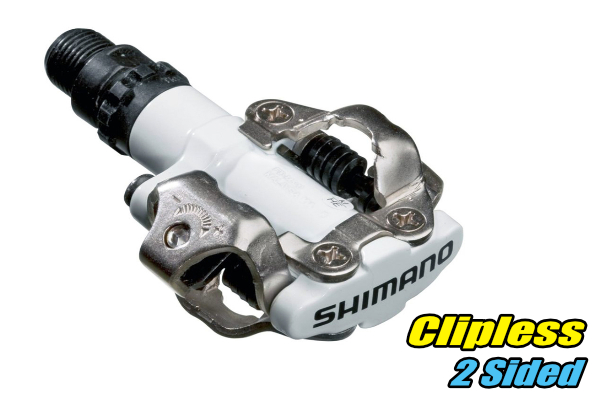
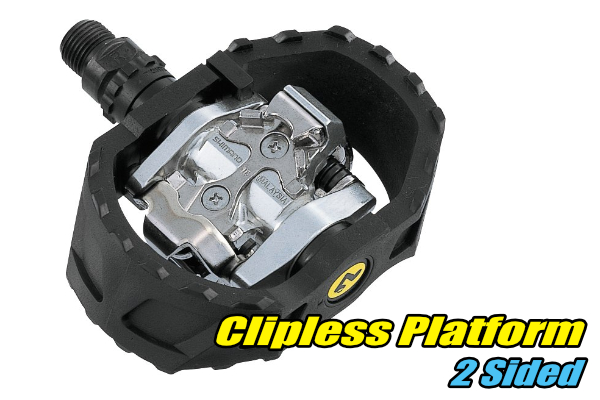
What are flat pedals?
A proper MTB flat pedal tends to be physically larger than a clip-in pedal. It has no system to lock your shoes on to the pedal. They have a few small, screw in or built in studs which stick up off the surfaces of the pedal to aid grip for appropriate shoes. Aside from that, they are essentially how most people would picture a pedal; a two sided platform to pedal with. For this reason, you will also hear them described as ‘platform‘ or ‘flat’ pedals. Although your average running shoes can be used on flat pedals, the knobby tread pattern of most runners tends to get caught on the flat pedals and be a hindrance. The flexible soles of runners also make them less than ideal. But they are a place to start if you need to. It is better though to buy a proper pair of mtb shoes specifically for using with flat pedals. They’ll have a far less flexible sole (but still allow you to walk comfortably) and the minimal tread pattern will be grippy on the pedal but not catch easily when you don’t them to.
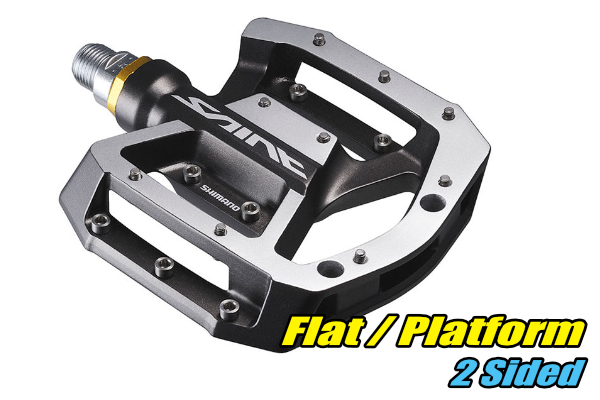
Best of both worlds
There is also the choice of a hybrid pedal that is a flat pedal on one side and a clip-in pedal on the other. These are built around the platform shape of a regular flat pedal but have the clip-in system available on the other side. Some even have the clever design of being clip-in and flat on both sides. In other words, the clip-in system doesn’t interfere with the flat surface when wearing mtb flat shoes. These hybrid styles save on having 2 sets of pedals if you are the type of rider that likes to ride with either type depending on your mood or type of riding you intend to do that day.
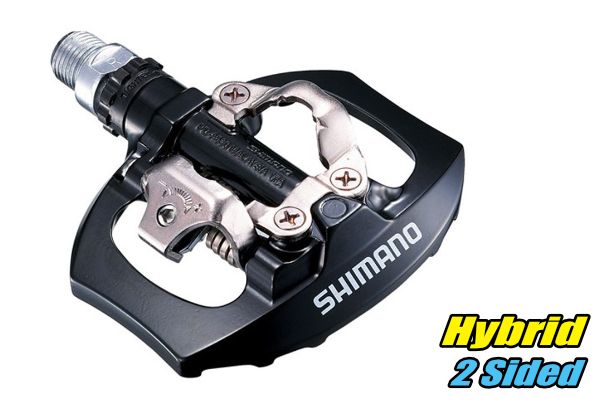
The clip-in pedal experience
Clip-in pedals and shoes are usually considered the domain of the cross country or trail rider. They help the rider to ensure more of their effort is transferred into the pedals and therefore the rear wheel. When set up correctly, they keep the foot in the correct position over the pedal and the stiff soled shoes help to ensure power to the pedal isn’t lost through shoe flex. Studies have shown that there is a small, but noticeable percentage increase in power when using clipless pedals. Over a long ride or race, this adds up to savings in energy and time gains.
Clip-in pedals and shoes also help to control the bike. However, if not properly adjusted they can also be inefficient. When a rider is clipped in, they have an advantage when it comes to lifting the rear wheel up and over obstacles. Hopping your body and lifting your feet brings the rear wheel up with you and tends to need less technique to accomplish than when using flat pedals. Riders who have used clip-in pedals exclusively will struggle to ride without them. They find that the feeling of being locked onto the bike brings confidence knowing that their feet will not bounce off the pedals at an awkward moment. They feel that they can influence the bikes behaviour through their legs and feet more easily.
Another factor might be that being clipped in helps with your pedalling technique. Pedalling in a quick, circular motion, as opposed to pumping your feet up and down only, is far more efficient and easier on your muscles. Developing a faster pedalling style tends to be easier when you are clipped in and your feet can’t, and don’t feel like they want to, fly off the pedals.
The flat pedal experience
Flat pedals can be used for any sort of mountain bike riding and they frequently are. However, they tend to be considered the domain of the downhill and stunt styles of mtb riding. This is because most downhill riders use flat pedals because they often need to use their feet for stability through turns and other similar situations. To unclip, use your foot, then try to clip back in on a fast, bumpy downhill track is often a recipe for losing time and possible disaster. However, there are some downhill riders who do use clip-in pedals on some tracks where they know there is a lot of pedalling to do or where being clipped in for bumpy sections is an advantage to them.
Back to the flats though.
As we just mentioned, flat pedals allow the rider to put their foot down whenever they want. Often it’s faster to stay on the pedals but sometimes, if you need to, it can be advantage also.
Another advantage is freedom of movement. Although clip-in pedals allow some movement, there are some more extreme body positions that require more movement of the feet than a clip-in pedal can allow. Advanced cornering techniques come to mind here, where the feet need to pivot dramatically on the pedals.
Keeping your feet firmly planted on flat pedals on fast, bumpy sections of trail might take some practice, likewise when hopping over a log etc. This is where technique becomes very important on flat pedals but less important on clip-in.
One of the disadvantages to flat pedals is the dreaded shin scrape. Slipping off the flat pedals does occasionally result in the cranks spinning around and violently striking you in the shins. And that hurts.
Mud is rarely an issue for flat pedals whereas it can be a real problem for some clipless types of pedal as it can stop the shoe cleat from clipping into the pedal properly.
Which type would we recommend for beginners?
Hmmm. Tough one.
When a beginner is unsure, is afraid or panics, their instinct is to put a foot down. When it’s clipped in, they are afraid they won’t be able to unclip quickly enough and end up toppling over. This fear will often them stop attempting challenging trail features. The confidence of being able to immediately slam a foot to the ground if something doesn’t feel right or doesn’t go well can be the difference between giving something a go or not. For that reason we would never try to encourage riders on to clip-in pedals until they feel they ready to do so. Having said that though, and because most beginners are going to be more cross country style riders than downhillers, we will encourage those who are willing and want to try, to go for clip-ins. If they do so, we would suggest they spend plenty of time simply clipping in and out of the pedals on flat surfaces and slight gradients until they are very confident with them. Like many skills in MTB, it’s not as difficult to learn as you might expect. However, there is good reason why the world’s top cross country style riders almost all use clip-in pedals and not flat pedals.
So to summarise then, if you are likely to be a cross country/trail rider who maybe does some races and tours around on scenic rides, then clip-in pedals could be the best choice for you. If you are more likely to stick to short rides, favour going downhill fast including big jumps and the like, then maybe flat pedals are a better choice.
We will say that starting on flat pedals usually forces you to learn the base skills of riding a mountain bike to higher levels of competency than using clip-in pedals. The skills you learn using flats can be carried forward if/when you switch to use clip-ins.
We hope this has helped.
